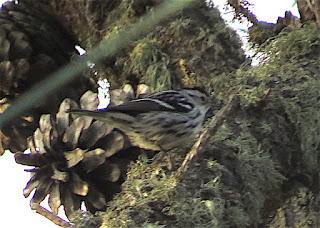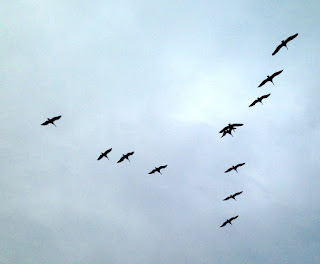It was an
odd-numbered year, so I was not offering my wonderful Oaxaca at Christmastime
tour in 2015 (and incidentally there is only one space left on the 2016 tour
already). That means going all out to do many Christmas Bird Counts and that I
can spend Christmas with family. Starting to look ahead already in October, I planned on spending Christmas
in the Napa Valley with my aunt and family, so using Ali Sheehey’s wonderful
compilation of California CBC dates, I searched for those occurring in the
southern Northern California region on either side of December 25. First up was
Marysville on December 22.
Early on the
22nd we met at the Carl’s Jr. about 50 minutes north of Fairoaks, a
suburb of Sacramento, where I stayed with my old friend Todd Easterla, and got our assignments. I was joined by my friends Jim
Tietz and Rebecca Green who live in the southern Sierra Nevada foothills. I had learned bird banding with Jim while we were both interns at
the Big Sur Ornithology Lab at Andrew Molera State Park exactly 20 years ago.
Our area today included parts of downtown Marysville as well as land along the
Feather River.
We birded
open fields, finding lots of White-crowned Sparrows.
American
Goldfinches flew over here and there.
It was
surprising to see a dragonfly active. This is a Sympetrum corruptum, Variegated Meadowhawk.
Not so
incidentally, one thing that attracted me to this CBC was that the compiler is
Tim Manolis, author and illustrator of the book Dragonflies and Damselflies of California. Yes, he’s also a birder.
I met him and his wife at Cristalino Jungle Lodge when I assigned to them as
their volunteer guide in October 2006 and hadn’t seen them since. He was
prepared to collect odonates then, with permission from the owner of the
property, and left his specimens with an odonatologist in São Paulo. One of the
damselflies I showed Tim was one that David Nunallee and I had found in 2004, photographed, and sent around
to experts who were stumped. Jump forward five years from my week with Tim and Annette, and in 2011 this
damselfly is named Austrotepuibasis
manolisi by Machado and Lencioni. They even erected a new genus for it.
Here’s my photo of that critter from 2004, and as far as I know it’s not been
found anywhere else. It could have been named Austrotepuibasis nunallee-hoyerorum.
We found a
sole Phainopepla, not a guaranteed bird on this CBC.
Another bug is a surprise, as it really has been winter
here, and the day before it really rained hard all day. But a bit disappointingly,
this is the introduced Harmonia axyridis,
Multicolored Asian Lady Beetle, though not a typical color pattern. Most have
much more white on the pronotum.
We pished up
a few Fox Sparrows, but they were strangely silent almost all day.
A crisp Lincoln’s
Sparrow.
We had the
sewage ponds where Lesser Yellowlegs was our best find.
Here are Jim
and Rebecca, Jim dutifully entering every bird into his eBird app.
Snowy and
Great Egrets at the junction of the Yuba and Feather Rivers
A Pacific
subspecies of the Bushtit, with the brown crown and pale face. They are
constantly moving, making them a very difficult subject to photograph.
This male
Anna’s Hummingbird staked out a Tree Tobacco as his territory but wasn’t
wasting any energy on singing or flying.
A
Red-breasted Sapsucker, subspecies dagetti.
Near the end
of our day we watched some 60 White-throated Swifts heading to their roost at
the bridge over the Yuba River, and this Merlin was surely wondering if they
were worth the challenge.
A male Purple
Finch in a dense riparian thicket.
A waxing
gibbous moon.
Then came a wonderful Christmas with aunts, uncles, cousins, and first cousins-once-removed.
I kind of
went crazy with being in charge of baking the pies – one pecan, two banana caramel coconut cream, one
blueberry, and two apple.
Then on
Sunday, December 27 came the Monterey Peninsula CBC. I birded the mouth of the
Carmel River with Bill Hill.
California
Towhee
This is the
epicenter of the wintering distribution of the Queen Charlotte Islands population
of Townsend’s Warblers.
Orange-crowned
Warbler
House Wren
In the
afternoon I birded along Carmel Beach and the neighborhoods of
Carmel-by-the-sea.
I found a
Nashville Warbler in one yard, but my best find was this Black-and-white
Warbler.
I then had a
day off between CBC’s in San Francisco’s Noe Valley neighborhood, staying with
friends.
After a fun
reunion in the evening with six of the seven members of the group I led in Mato
Grosso this past early August, I did the San Francisco CBC the next day (my
fourth time doing this CBC, though so poorly organized it was perhaps my last
for a while). But I left my camera at my friends Joe and Robbie’s house, so no
photos. I covered Baker Beach and Lobos Creek in the morning and the Presidio
Main Gate area in the afternoon, finding no rarities, but my best birds were two
White-throated Sparrows and a Red-naped x Red-breasted Sapsucker hybrid in the
Presidio.
Dawn on Wednesday,
December 30 saw me at Shollenberger Park in Petaluma to meet up with the larger
team covering the SW edge of the Sonoma Valley CBC circle. What a contrast in
organization. I knew that the compiler was a veteran CBC organizer, though we
had never met in person. Gene Hunn had compiled the Oaxaca Valley CBC for the
nine years that I led or co-led that tour from 1997-2005, with me or my tour
group being one of the CBC teams each year. And this year he had designated the
super organized Peter Colasanti to head up the Petaluma Wetlands team. In the
morning I was assigned to a team with three others to cover part of Tolay Regional
Park, a former ranch in the Petaluma Valley and the adjacent foothills to the
east.
We soon
found one of our target birds, a couple pairs of Vesper Sparrows that had been
staked out for a few weeks.
Another
target for us was Golden Eagle, which we found perched in an oak tree on the
hillside.
The weather
wasn’t gorgeous today, but the extremely fine mist at times and cool air kept
us from getting overheated on our hike up the hillsides.
These huge mushrooms
under the oaks are Amanita calyptroderma,
one of the edible species in this genus. The white on the cap is the remnants
of the universal veil, distinctively thick in this species.
We flushed
Savannah Sparrows, Western Meadowlarks, and Long-billed Curlews in this habitat.
On a similar
open grassy slope with a little rock outcropping I flushed a Rufous-crowned
Sparrow. It was interesting to see this species in a totally different
ecoregion where they are rather local and rare from where I’m used to seeing
them in SE Arizona at the epicenter of their abundance and distribution.
In the
afternoon I had a change of habitat at the mouth of Ellis Creek. A flock of
American White Pelicans flew over.
My friend
Josiah Clark spotted this amazingly tame American Bittern.
We saw lots
of duck species, lots of Song and Savannah Sparrows, gulls, and shorebirds, and I managed to get a
vocal response from a Ridgway’s Rail. When we peered into the neighboring
oxidation ponds (covered by a different group), we saw dozens of swallows
feeding low over the water. It’s not uncommon to see a few overwintering Tree
Swallows, but these birds were actually dominated by Violet-green Swallows,
which normally winter in Mexico. I also spotted a single Barn Swallow, which we
all saw well. Over the ponds on our side of the ditch I finally got a bad photo
of one of the Violet-green Swallows just to show we weren’t making this up.
















































Very nice - looks like some very successful hikes.
ReplyDeleteYou had what looks like a busy but fun holiday! Glad you got to get crazy with pie baking, that looks very festive. Beautiful photos as always.
ReplyDeleteAustrotepuibasis nunallee-hoyerorum: the name they should have chosen. 🎶
ReplyDelete